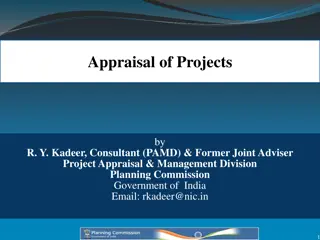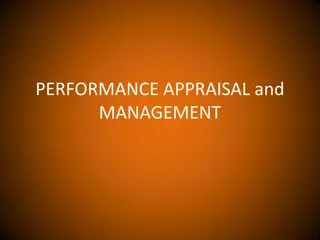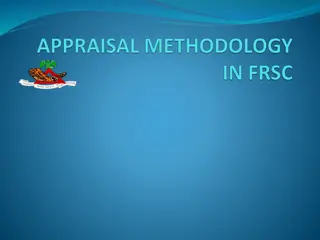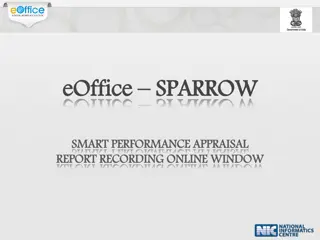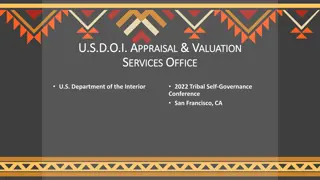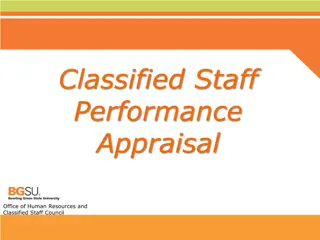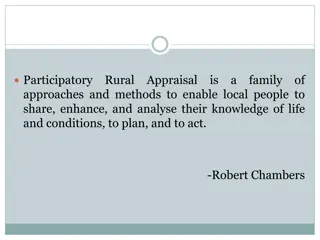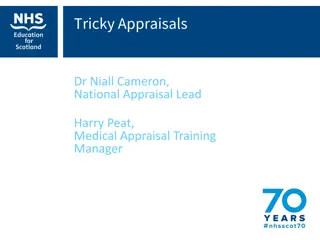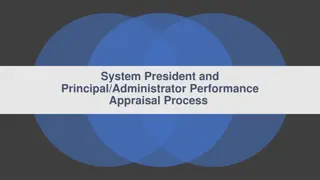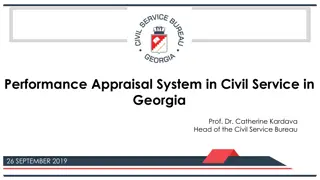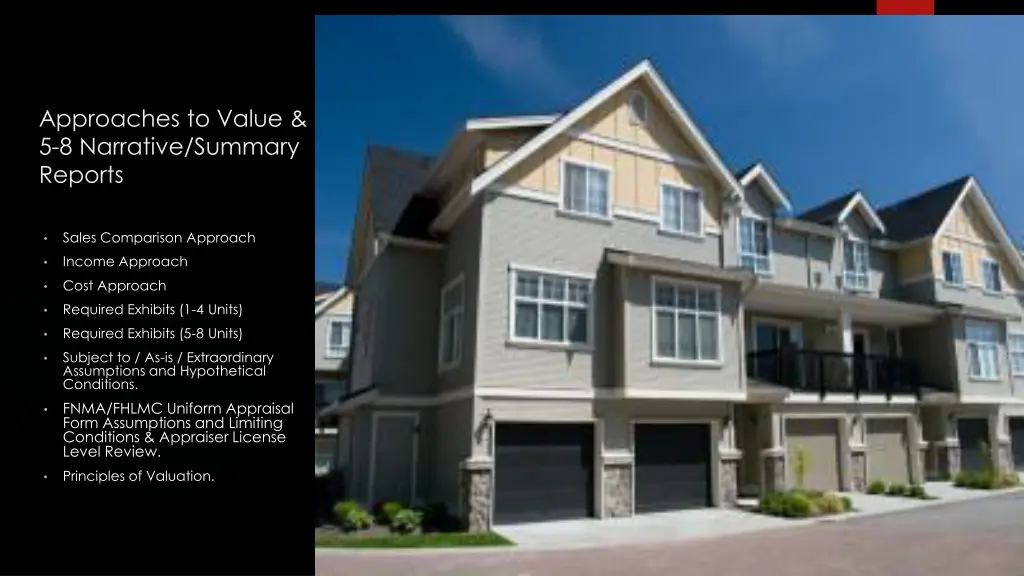
Property Valuation Approaches Explained
"Learn about the Sales Comparison Approach in property valuation, where recent sales and listings are analyzed to determine the property's value. Discover the mechanics, data sources, and adjustment methods used in this approach to accurately appraise real estate."
Download Presentation

Please find below an Image/Link to download the presentation.
The content on the website is provided AS IS for your information and personal use only. It may not be sold, licensed, or shared on other websites without obtaining consent from the author. If you encounter any issues during the download, it is possible that the publisher has removed the file from their server.
You are allowed to download the files provided on this website for personal or commercial use, subject to the condition that they are used lawfully. All files are the property of their respective owners.
The content on the website is provided AS IS for your information and personal use only. It may not be sold, licensed, or shared on other websites without obtaining consent from the author.
E N D
Presentation Transcript
Approaches to Value & 5-8 Narrative/Summary Reports Sales Comparison Approach Income Approach Cost Approach Required Exhibits (1-4 Units) Required Exhibits (5-8 Units) Subject to / As-is / Extraordinary Assumptions and Hypothetical Conditions. FNMA/FHLMC Uniform Appraisal Form Assumptions and Limiting Conditions & Appraiser License Level Review. Principles of Valuation.
Sales Comparison Approach Recent sales and listings of similar type properties in the area are analyzed to form an opinion of value. This approach, formerly known as the market data comparison approach, is the approach most of us are familiar with. The mechanics of the sales comparison approach involve the use of sales and market data of all kinds in order to compare closely the property being appraised with other similar properties which have recently been sold or are offered for sale as to time of the sales, location of the sales and physical characteristics of the improvements. Sources of Data: Sales of market data are obtained from many sources including, but not limited to: Appraiser s own files (Information gathered on previous assignments might provide information for the present appraisal). Public records County assessor offices keeps a record of all sales transaction recorded within the county. The date of recording of any deed may be obtained from the recorder s office. MLS, Appraisal Peers, or Brokers. Legal property owner, sellers or buyers. Classified ads or listings. The procedure used in the sales comparison approach method is to systematically assemble data concerning comparable properties. Appraisers considers the principle of substitution, seeking comparables that are as like the subject as possible regarding neighborhood; location; site; improvement size; bedrooms and bathrooms; age; architectural style; financing terms and general price range. Paired Sales Analysis: Dollar adjustment: Subject property has a swimming pool. One sale like the subject with a pool sold for $400,000, while another sale like the subject without a pool sold for $375,000. The $25,000 difference can be attributed to the contributory value of the pool. Percentage adjustments: Are best used when the sales are not recent and market conditions may or may not have changed from the date the sales occurred to the date of the valuation. The procedure is to look for the most recent sale with the same attribute (feature) as the subject. Once the sale is found, find a corresponding sale with a different attribute that was close in date of sale. If not available, then search further back in time until you come across the next sale with the same attribute as the subject. Look for a corresponding sale with a different attribute that is close in date of sale. If unable to obtain corresponding sales within a similar time frame, repeat this process, until a sale with the same attribute is found and corresponding sale without the attribute is found that is close to the date of sale. Once found, the percentage difference is determined between the two sales. Example: Subject is an ocean view condo but there has been no sales of similar ocean view condos in the past 12 months. The appraiser will search back in time until he/she finds a sale with an ocean view and then search within the same time period for a sale without the ocean view. Once located they can extract the percentage difference for ocean view vs. non-ocean view.
Sales Comparison Approach Example: Appraised Value is $260,000.00 In this example the $260,000 opinion is not supported. The unadjusted range of value (closed sales only) is $236,500 - $250,000. All the closed sales are adjusted upward to form an adjusted value range of $258,000 - $269,848. The listings carry no weight as they are not closed sales. Opinion of value needs to be supported by the unadjusted and adjusted range of value. *Appraiser is reporting there were 29 sales in past 12 months with the highest sale being $255,000.
Income Approach: The Income Approach is concerned with the present worth of future benefits (income stream) which may be derived from a property. This method is important in the valuation of income properties. An important consideration in this approach is the net income which a fully informed person using competent management can expect to receive. The process of calculating the present worth of a property based on its capacity to produce an income stream is called capitalization. The income approach is based primarily on the appraisal principle of anticipation. Capitalization: Capitalization converts the future income stream into an indication of present worth of the property. Two income capitalization methods are used in an appraisal. Direct Capitalization and Yield Capitalization. In Direct capitalization, such as overall rate and GRM analysis, the income from a single annual period is converted to an opinion of value. In Yield capitalization, measures the present worth of a series of income payments occurring over the multi-year life of the investment. The most common approach is the direct income capitalization using an Overall (capitalization) Rate. The preferred method of Overall Rate derivation is from an analysis of comparable sales and their relationship between net income and sales price. The appraiser analyzes each comparison property s sales price, rents, expenses, net income and Overall Rate, makes needed adjustments and selects an appropriate indicated Overall Rate for the property being appraised. This rate represents both the return on and the return of the investment. To ensure reliability of the selected rate, the appraiser uses judgment and experience to make certain the comparables and the subject property have similar age, physical, location, income, expense and risk characteristics. The Overall Rate Formula is: Net Annual Income divided by Overall Rate = Property value. If any two factors are known in the formula, the third can be obtained. Net Annual Income = Overall Rate x Property value. Overall Rate = Net Annual income divided by value. Procedure for Direct Capitalization is to 1) determine the net annual income; 2) select the appropriate cap rate by market comparisons; and 3) Capitalize the income (divide the net annual income by the cap rate). Determining Net Annual Income: 1) Estimate potential gross income the property I capable of producing. 2) Deduct from potential gross income an annual allowance for vacancy factor and rent collection loss. The remainder is called the effective gross income. 3) Deduct from effective gross income the estimate probable future annual expenses of operation (fixed expenses, variable expenses, reserves for replacements for building components or short-lived items) to obtain the net income of the investment property. Example: Based on an annual net income of $30,000, and an Overall Rate of 6%, the capitalized property valuation would be $500,000 (income divided by rate). Capitalizing the same income with an Overall rate of 7% would result in a value of $428,500.
Income Approach (continued): Gross Rent and Gross Income Multipliers: Typical investors in certain types of income properties analyze and purchase them on a gross, rather than net, income basis. Gross Rent Multiplier (GRM) and Gross Income Multiplier (GIM) analyses are also Direct Capitalization techniques that covert a projected single-year income to an indication of market value. The Gross Rent Multiplier (GRM) involves the analysis of the gross rents attributed to a property. The Gross Income Multiplier (GIM) is appropriate when additional sources of income are considered significant by typical potential investors in the property (parking fees, etc.). The Gross Income Multiplier includes the analysis of all gross income generated by the property. GRM or GIM may be derived on either a monthly or annual basis but must be applied consistently. GRM is calculated by dividing the sales price of an income property by its monthly rent. Steps in using the Gross Rent Multiplier: 1) Determine the market rent by comparison with similar properties. 2) Extract the GRM from comparable properties. 3) Rent multipliers may then be tabulated showing how these properties varied from the subject property (better or poorer). 4) The GRMs are not averaged to arrive at one final multiplier. Rather, each property and its multiplier is compared to the subject property as to market rent, location, size, condition, utility, and amenities AND after proper analysis, a judgement is made as to the appropriate GRM. 5) The Appraiser multiples the selected GRM by the market rent of the subject property. The product is the value estimate.
Cost Approach: The cost approach is a valuation method that estimates the price a buyer should pay for a piece of property is equal to the cost to build an equivalent property. The cost approach views value as the combination of the value of the land as if vacant; and the cost to reconstruct the appraised building as new on the date of value, less the accrued depreciation the building suffers in comparison to a new build. Cost Approach to value is not as reliable for older homes. Cost approach yields the most accuracy when used for newer dwellings/improvements. The cost approach is considered less reliable than other valuation methods but can be useful in certain cases such as when evaluating new construction or a unique home with few comparable sales.
Required Exhibits 1-4 Family (Non-FHA Reports) 5-8 Multifamily Building footprint sketch or floor plan and calculations. Full interior inspection AND photos of all units are required. *Interior/Exterior photos should follow 1-4 family requirements unless specified differently below. Must be software generated (not hand drawn) and indicate dimensions and calculations that demonstrate how the estimate for GLA was derived. Rent Roll is required. If interior layout of dwelling unit(s) is atypical or functionally obsolete, thus limiting the market appeal in comparison to competitive properties the floor plan must also include Interior walls, doorways, staircases, exterior ingress/egress, labels for each room, and provide the dimensions of all exterior walls. *Unit in apartment style condo the sketch of the unit must indicate interior perimeter unit dimensions. Income and Expense Statement is required. Photos including interior/exterior and street scene are required. Photos of sales comparables and rental comparables used in the analysis is required. Aerial Photo is required. Street Map showing location of subject and comparable sales. Sketch or Floor plan is required. Exterior Photos: Clear, descriptive color photos showing front, rear, and street scene of subject property and front of each comparable sale. Map with subject/comparable sales is required. Appraisers will not trespass on private property for exterior comp photos and will take the best photo possible from the public access point. MLS photo will sometimes be supplemented; however, this is not a requirement, and some MLS services prohibit data sharing outside of the MLS. Plot Plan or Survey. Appraiser Qualifications. No Fair or Poor ratings allowed. Interior Photos: Report must include photos of the kitchen, all bathrooms, main living area, examples of physical deterioration (if present), and examples of recent updates (such as restoration, remodeling and renovations, if present). *Interior photos can be taken when 1004D is completed for properties under construction. No environmental issues allowed. No health or safety issues allowed. No excessive deferred maintenance that could become a health or safety issue allowed. Bedroom photos are not a requirement. No structural deferred maintenance. Photos of CO/Double Strapped water heaters in markets where required are not required. Fyi Rental Comp photos ARE NOT required on 1025 or 1007. Most appraisers will include anyway.
Subject to, As-Is, Extraordinary Assumptions, and Hypothetical Conditions FNMA/FHLMC Uniform Summary Report forms can be completed in 4 different ways: As-is. (No repairs or anything is needed the opinion of value is As-is). Subject to completion per plans and specs based on a hypothetical condition that the improvements have been completed. (Appraiser is making a hypothetical condition the property is complete and appraising the property as completed). **1004D Final is required. Subject to repairs/alterations based on a hypothetical condition repairs/alterations have been completed. (There are identifiable repairs which need to be cured). **1004D Final may be required depending on scope of repairs. Subject to a required inspection based on the extraordinary assumption the condition or deficiency does not require alteration or repair. (The appraiser is unsure if a repair is required, and identifying the repairs needed, if any, is outside the appraiser s scope of expertise). **No 1004D Final is needed. Extraordinary assumptions and Hypothetical Conditions can be made outside of the subject to selections. USPAP requires appraisers to clearly disclose any extraordinary assumptions or hypothetical conditions applied and how they could impact the opinions and conclusions in the report. All extraordinary assumptions and hypothetical conditions should be viewed carefully to determine if acceptable. Extraordinary Assumption: Is an assumption made by the appraiser for something unknown as of the effective date of the report. Common extraordinary assumption is when an appraiser notices an issue during the visual inspection which may or may not require repair, but it is outside the appraiser s scope of expertise to determine if a repair is or is not needed. The appraiser will use an extraordinary assumption to address these type of concerns. Hypothetical Condition: Is a condition related to the specific assignment which is contrary to what is known by the appraiser to exist on the effective date of the assignment. Example: Appraisal is completed subject to plans & specs/completion of the dwelling. Example Unacceptable Extraordinary Assumption: Appraiser was not able to access 2 bedrooms; the appraiser has made an extraordinary assumption these areas are in similar condition as rest of the dwelling and have no functional obsolescence. Example Unacceptable Hypothetical Condition: The subject property is a SFR on 25-acre parcel. The appraiser has not been provided a survey but has appraised dwelling and only 5 acres based on the hypothetical condition the property is 5 acres with dwelling. Extraordinary assumption(s) and hypothetical condition(s) need to be reasonable. Example, you cannot appraise a MN property with a hypothetical condition the property is ocean front, etc. USPAP Requirement: USPAP requires the appraiser to clearly disclosure of any extraordinary assumption(s) or hypothetical condition(s).
FNMA/FHLMC Uniform Appraisal Form Assumptions and Limiting Conditions & Appraiser License Level Review. The uniform FNMA/FHLMC appraisal forms include a list of assumptions and limiting conditions. It is important to understand these assumptions and limiting conditions. #1: Appraiser is assuming the title is good and marketable and will not render any opinions about the title. #2: Sketch within the report is approximate and included to assist in visualizing the property and understanding determination of size. #3: Appraiser is not an expert in flood certifications you should consult an expert. #4: Appraiser will not give testimony or appear in court unless required by law or specific arrangements have been made prior to completion of the assignment. #5: Appraiser completes a visual inspection and notes any observed or known conditions. Appraiser is not responsible for hidden defects or other items outside scope of expertise and/or not disclosed. #6: If report is completed subject to repairs the assumption is repairs will be preformed in a professional manner. Appraiser Certifications: There are 25 certifications which the appraiser attests to with his/her signature on the report. The 25 certifications are self-explanatory and should be read and understood. There are also Supervisory Appraiser certifications which are applicable when a trainee or appraiser is required to be supervised. Licensed and Certified Appraiser: What each type of license or certification can appraise along with education requirements. Licensed Appraiser: Can complete appraisals on non-complex residential assignments with a transaction amount (loan amount) of up to $1M. Can also complete appraisals on complex residential assignments with a transaction amount of $400,000 or less. Education Requirements: 150 hours of qualifying education and 1000 hours of acceptable appraisal experience in no less than 6 months. *Cannot complete FHA assignments or be on the FHA Approved Roster of Appraisers. Certified Residential Appraiser: Can complete complex and non-complex residential assignments for any transaction amount. Education Requirements: 200 hours of qualifying education, 1500 hours of acceptable appraisal experience in no less than 12 months, and Bachelor s degree, Associate degree in focused field of study (business, economics, or real estate, or 30 college semester credit hours. Certified General Appraiser: Can complete complex and non-complex residential and commercial (AG, etc.) assignments for any transaction amount. Education Requirements: 300 hours of qualifying education, 3000 hours of acceptable appraisal experience in no less than 18 months, must have a bachelor s degree or higher.
Principles of Valuation Understanding the basic assumptions, postulates or premises that underlie appraisal methods is essential to an understanding of purpose, methods, and procedures of valuation. The following principles of value influences are important for a general understanding of the appraisal process. Principle of conformity: Holds that maximum value is realized when land uses are compatible, and a reasonable degree of architectural harmony is present. Zoning ordinances help set conformity standards. Principle of change: Real property is in a constant state of influx and change, affecting individual properties, neighborhoods, and cities. The appraiser follows tends and influences and is sensitive to change in conditions that affect the value of real estate. Economic, environmental, government, and social forces affect all markets, especially real estate. Principle of substitution: This principle is the basis of the appraisal process. Simply stated, value will tend to be set by the cost of acquiring an equally desirable substitute. The value of a property to its owner cannot ordinarily exceed the value in the market to persons in general, when it can be substituted without undue expense or serious delay. In a free market, the buyer can be expected to pay no more, and a seller can expect to receive no less, than the price of an equivalent substitute. Example: A property owner states that owner s house is worth $95k. Buyers in the market can obtain a substitute property with same features and utility for only $90k. The seller s house, therefore, has a value of approximately $90k and not $95k. Principle of supply and demand: Holds that price varies directly, but not necessarily proportionately, with demand, and inversely, but not necessarily proportionately, with supply. Increasing supply or decreasing demand tends to reduce price in the market. The opposite is also true. Principle of Highest & Best Use: The best use of a parcel of land, known as its highest, best, and most profitable use, is that which will most likely produce the greatest net return to the land over a given period. This net return is realized in terms of money or other amenities. The application of this principle is flexible. It reflects the appraiser s opinion of the best use for the property as of the date of the appraisal. Examples: At one period, the H&BU of a parcel in a downtown business district might be for the development of an office building; at another time, a parking lot may be the H&BU. Or a SFR on a commercial lot may not be the H&BU for the site. Or a 4-unit apartment on multiple zoned land for 30 units is probably not the long-term H&BU of the land. The appraiser applies four accepted tests in arriving at the highest and best use for a property. The use must be (1) Legally permissible; (2) Physically possible; (3) Economically feasible; and (4) The most productive use. Determining highest and best use includes assessing potential buyers motives, the existing use of the property, potential benefits of ownership, the market s behavior, community or environmental factors, and special conditions or situations which come to bear on appraisal conclusions of value. Principle of progression: The worth of a lesser-valued object tends to be enhanced by association with many similar object of greater value. Principle of regression: The worth of a greater-valued object is reduced by association with many less-valued object of the same type.
Principles of Valuation (cont.) Principle of contribution: a component part of a property is valued in proportion to its contribution to the value of the whole property or by how much that part s absence detracts from the value of the whole. Maximum value is achieved when the improvements on a site produce the highest (net) return, commensurate with the investment. Principle of anticipation: Value is created by anticipated future benefits to be derived from the property. In the Market Value Analysis, appraisers estimate the present worth of future benefits. This is the basis for the income approach to value. Simply stated, the income approach is the analysis of the present worth of projected future net income and anticipated future resale value. Historical data are relevant because they aid in the interpretation of future benefits. Principle of competition: Competition is created where substantial profits are being made. If there is a profitable demand for residential construction, competition among builders will become very apparent. This could lead to an increase in supply in relation to demand, resulting in lower selling prices and unprofitable competition, leading to renewed decline in supply. Principle of balance: Value is created and sustained when contrasting, opposing, or interacting elements are in equilibrium, or balance. Proper mix of varying land uses created value. Imbalance is created by over-improvement or under-improvement. Balance is created by developing the site to its H&BU. Principle of four-stage life cycle: In due course, all material things go through the process of wearing or wasting away and eventually disintegrating. All property is characterized by four distinct stages growth, stability, decline, and revitalization. Example: Single properties, districts, neighborhoods, etc., tend generally to follow this pattern of growth and decline. It is also evident this process is frequently reversed as neighborhoods and individual properties in older residential areas are renewed and restored. Moreover, revitalization and modernization in inner-city older neighborhoods may result from organized government programs or as a result of changing preferences of individual buyers. Most neighborhoods remain in the mature or stable stage for many years, with decline hardly noticeable as renewal becomes essentially an ongoing process. Basic Valuation Definitions: There are many different designations or definitions of value. They may be divided into the following two main classifications: Utility Value, which is value directed toward a particular use. This frequently is termed subjective value and includes valuation of amenities which attach to a property or a determination of value for a specified purpose or for a specific person. Market value, which represents the amount in money (cash or the equivalent) for which a property can be sold or exchanged in prevailing market conditions at a given time or place as a result of market balancing. It may be based on a willingbuyer and willingseller concept. This is frequently termed the objective value, since it is not subject to restrictions of a given project. Appraisers carefully define the value being sought. Types of values include Liquidation Value, Market Value, Investment Value and, of course, Assessed Value (for taxation).
Principles of Valuation (cont.) Market Value Defined: In appraisal practice, the term Market Value is defined by agencies that regulate federal financial institutions in the U.S. That definition is given as: The most probable price which a property should bring in a competitive and open market under all conditions requisite to a fair sale, the buyer and seller each acting prudently and knowledgeably, and assuming the price is not affected by undue stimulus. Implicit in this definition is the consummation of a sale as of a specified date and the passing of title from seller to buyer under conditions whereby: 1. buyer and seller are typically motivated; 2. buyer and seller are well informed or well advised and acting in what they consider their own best interest; 3. a reasonable time is allowed for exposure in the open market; 4. payment is made in terms of cash in United States dollars or terms of financial arrangements comparable thereto; and 5. the price represents the normal consideration for the property sold, unaffected by special or creative financing or sales concessions granted by anyone associated with the sale.
The Appraisal Process USPAP Standards 1 and 2 guide the appraiser through the appraisal process. Standard 1 covers all the development activities that are distinctly different from the final step, reporting, which is covered in Standard 2. The following summarizes the appraisal process required in Standard 1: 1) Define the appraisal problem. Identify the client and intended users. Identify the intended use. Identify the type and definition of value. Determine the effective date of the opinion. (Current = inspection date. Retroactive = date in the past. Prospective = future date). Identify the relevant characteristics of the subject property. Identify assignment conditions (extraordinary assumptions and hypothetical conditions). 2) Determine the scope of work necessary to solve the appraisal problem. 3) Perform data collection and analysis. Market analysis (demand studies, supply studies, marketability studies). Highest and best use analysis (site through vacant, ideal improvement, property as improved). 4) Application of the approaches to value. Cost Approach Sales Comparison Approach Income Approach 5) Reconciliation of value indications and final opinion of value. Standard 2: Sets forth the actual reporting of the value opinion. USPAP defines the report as, Any communication, written or oral, of an appraisal, appraisal review, or appraisal consulting service that is transmitted to the client upon completion of the assignment. Standard 2 cover the final step in the appraisal process and addresses both the reporting and communication.
The Appraisal Process (cont.) Summary and narrative reports will follow the same process outlined in USPAP Standard 1 and USPAP Standard 2. Summary and narrative reports will both consider all three (3) approaches to value. In some cases, an approach may not be applicable to the assignment. Narrative reports are in a different format vs. a summary report but both have similar information. The narrative report provides a more detailed written format vs. the summary report. Summary reports (1004/1073/1025/etc.) summarize the data. Appraisers will keep a work file for both types of reports. Narrative report will generally consist of: Letter of transmittal Summary of important conclusions. Regional and neighborhood analysis. Description of the site and any improvements. Highest and best use analysis. Zoning analysis and Tax analysis. Statement of ownership and Property rights appraised. Scope of work. Cost approach, Income approach, and Sales comparison approach, utilizing comparable sales on the comparison grid. Reconciliation. Definition of market value. Certification, contingent and limiting conditions. Photos of the subject property. Photos of all comparable sales used and comparable sales location map. Sketch of subject property showing layout, dimensions, and how the appraiser calculated the estimated GBA.


